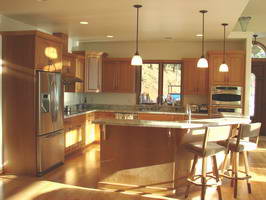Question – Cords and How to Identify the Individual Wires – Part 2
 '; ';
|
Smooth side, ridged side: Which is which? © By: Dave Rongey |
Let me explain what come up recently to cause my concern…
I got a pendant light to replace an older light over the kitchen sink…
Looking at the light and wiring at the store, I noticed the wire coming up thru’ the rods was 1 piece, (but of course would have to be cut off to make the pendent shorter, as it adjusts to 3 different lengths),,,, The wire coating was all one color (like an extension cord would be),,, so I made the comment to the salesman, about that, and he said “when you cut the wire to fit the extension rod (leaving about 6 inches) separate the cord and strip off about 1/2 inch off each. Use the wire from the side with the ridge to connect to the Black (hot) wire that the old fixture was previously connected to.
So, his statement was not true then ???? And he told me the opposite way ????
What would have happen if I would have already installed it the way he told me ????
(By the way, it does NOT say anything about how to determine the HOT wire from the light fixture in the instructions that come with the fixture.)
Thank you SO much for all your help with my questions !!
[ad#block]Well we certainly have a situation here, don’t we.
I’m afraid the salesman gave you wrong information, and I just re-affirmed this again by reaching for a two wire cord, one that has a large prong, and has the ridges on the cord, and I know that this plugs into a receptacle only one way – which would be the ridged side on the Neutral/Silver Screw side.
Honestly, this can be confusing – and that’s why even I double check the wire ribs to make doubly sure.
So – if you already connected a fixture with the wires reversed to a standard pendant fixture with an incandescent bulb socket, it means that the bottom contact is Neutral and the larger area which travels up where you may possibly come in contact with it – is now energized when the light is turned on.
Here is the Danger Scenario with all these conditions being met:
If you ever were to change the light bulb,
AND the fixture was turned on,
AND your fingers came in contact with the base of the bulb,
AND any part of your body came in direct contact with a grounded surface,
THEN you would get shocked.
The sad truth is that there are most likely countless fixtures wire backwards this way, especially if they followed a “salesman’s” advice, and most people would never know differently. Does this cause a fire hazard – not directly, it’s just not the right way to do it. The energized contact should be at the bottom of the lamp socket where it is less accessible to fingers and other objects.
You just happen to be a very observant and wise individual who knew enough to ask, and ask again. I guess that’s why I’m not a salesman!
Hey – here’s an idea. Go back to the store, find a two or three wire cord that has these ribs, go find the salesman and while you hold the cord behind your back – ask him about how to wire your fixture again. If he gives you the same answer, you could either ask him to explain why all the cords in the store are wired backwards, OR you could ask him to explain the why the cords are wired differently, or you could just smack him with the cord, or you could just do what ever your heart desires. Just don’t get too radical. The poor guy got some bad advise from – who knows where. Hey – you could always tell him to visit my web site and when in doubt – ask a question, just like you did!
(Sorry, it’s late and I felt like having a little humor ; )
I hope this helps. Let me know what happens, now I’m really curious about what you’re going to do!
Cords and How to Identify the Individual Wires – Part 1
Cords and How to Identify the Individual Wires – Part 3
The following may also be helpful for you:
|
|
Be Careful and Be Safe - Never Work on Energized Circuits!
Consult your Local Building Department about Permits and Inspections for all Electric Wiring Projects.
More articles about Identifying Wires Questions and Home Electrical Wiring: |
|
| « Previous | Next » |
Question – Cords and How to Identify the Individual Wires – Part 3 |
Question – Cords and How to Identify the Individual Wires – Part 1 |














